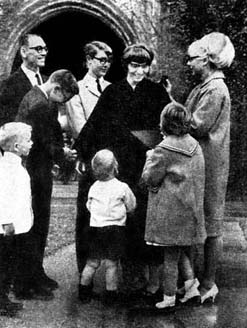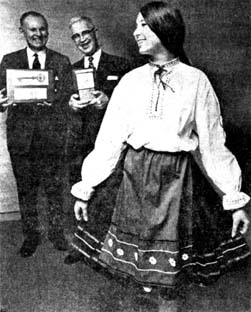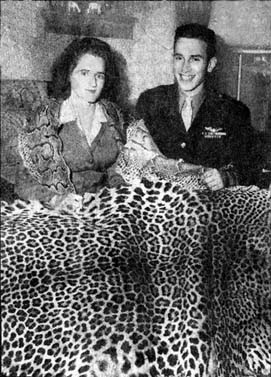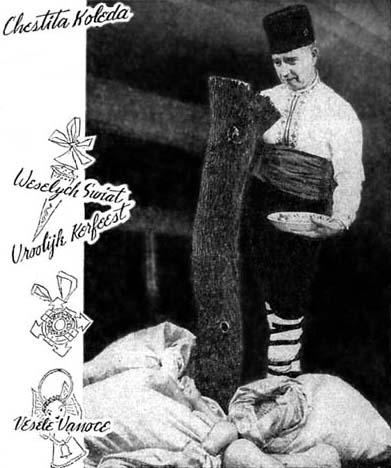Captain Colchagoff Studies Volcano Which
Thrilled Him as Student
by Marie Bollinger
 Little did Capt. George D. Colchagoff, Toledo, know when he left his engineering
studies at the University of Toledo for a brief holiday in Mexico City
some years ago that he would be down there again in 1945 in line with military
duties studying what had been of great interest to him as a tourist, the
newly-born Paricutin volcano.
Little did Capt. George D. Colchagoff, Toledo, know when he left his engineering
studies at the University of Toledo for a brief holiday in Mexico City
some years ago that he would be down there again in 1945 in line with military
duties studying what had been of great interest to him as a tourist, the
newly-born Paricutin volcano.
Captain Colchagoff was called into the service
with the rest of his buddies and managed to line up a fine record for himself.
Serving with the Ninth Air Force under General Brereton he participated
in the Ploesti oil field raid in Romania August 1, 1943. He has seen action
as a pilot of a B-24 in both the European theater and in the Middle East.
There he earned for himself the Distinguished
Flying Medal, the air medal with four Oak Leaf Clusters, and the unit citation.
Quite an array of decorations and one which a civilian observer might say
would earn him a much needed rest.
But not for Captain Colchagoff, for he was
returned from overseas on Aug. 27, 1943, to serve at Wright Field as aeronautical
engineer.
Then down Mexico way came the call for scientists,
a helicopter, and trained men to man it. It seemed that there was a great
deal of interest in the Paricutin volcano there and that scientists so
far had been unable to get close enough for adequate observation of new
lava flows and eruptions.
The mission of American scientists arrived,
a new model Sikorsky helicopter appeared, and at last, the two air corpsmen
came, Flight Officer Ray Beer, Mansfield, O., and Captain Colchagoff.
When the ATSC was queried about sending down
men and a plane they had been interested as the altitude, temperature,
and air turbulence in the volcanic area approximated those in the CBI theater
and so they agreed to the venture.
The Wright group has completed 62 missions
over the Paricutin area (22 hours flying time) and the reports of the scientists
abroad doing research on the volcanic conditions have not only proved of
interest to the civilian world, but have provided some valuable flight
data to the ATSC.

--Blade Photo
LARGE FAMILY NO BAR TO SCHOLARSHIP
Mrs. Colchagoff with her husband and six children
Mother Wins Degree, Honors
At TU After 12 Years Work
Quit School For Lack Of Funds, Returned
To Take Day, Evening, Summer Courses
A mother with a family of six children was
awarded a degree it took her 12 years to earn at the University of Toledo
commencement last night.
Mrs. Beth Ann Colchagoff received the degree
of bachelor of education magna cum laude. It was the successful conclusion
of an academic endeavor begun in 1954, after she was graduated from Waite
High School.
Mrs. Colchagoff started as a full-time student
at TU, but lack of funds compelled her to quit and take a job. She was
a part-time student when she married. During the past 12 years she has
attended TU off and on during the day or evening and in summer school,
as circumstances permitted.
Mrs. Colchagoff and her husband, Robert, live
at 3424 Valleston Pkwy. with their six children, aged 2 to 17. Mr. Colchagoff
is a mechanical engineer at Owens-Illinois, and three of his children are
from an earlier marriage. Mrs. Colchagoff plans either to teach or go to
graduate school next fall.

--Blade Photo
 1957
1957The Toledo Times
SATURDAY, JULY 26, 1958
News Of This And That
Manhattan Bound
BY BETTY MARSH
The visitors are Mrs. Clyde Sussex and daughters Gail, 11, and Robin, 6, and son, Mark, 8, of Tampa, Fla. They are guests in the Holland home of Mrs. Sussex's parents, Mr. and Mrs. Demeter Colchagoff of Crissey Road. Mrs. Sussex is the former Mary Ellen Colchagoff.
The Floridians motored here to attend the wedding today of Beth Hamm and Mrs. Sussex's brother, Robert Colchagoff, Crissey Road, who will exchange nuptial vows at an afternoon ceremony in First Unitarian Church, with a reception following in the home of the bridegroom-elect.
Joining in a family gathering planned for tomorrow will be the Sussex children's paternal grandparents, Mr. and Mrs. Charles Sussex of Jackson. Mich., who will motor here to spend the day in the Demeter Colchagoff home.
Also expected to attend are Clyde Sussex's brother and sister-in-law, Mr. and Mrs. Melvin Sussex and his brother-in-law and sister, the Philip Conleys, all of Jackson.
1960s
It's a tree, all right, but not the usual conception. Demeter Colchagoff looks into the hollow tree that forms a kind of horn of plenty in some of the provinces of Bulgaria. Grandfather pours grain through the tree while the family gathers in the living room -- and the grandmother catches it in the bowl.
( Picture is shown at 75 per cent. Click on picture to show at full size)
TOLEDO BLADE
TOLEDO, OHIO, TUESDAY SEPTEMBER 21, 1943
Souvenirs From Africa

--Blade Photo
WHAT THE well-dressed bomber pilot's wife will wear after the war is modeled here by Mrs. George Colchagoff, 217 Worthington St. Her husband, Captain Colchagoff brought the leopard and boa constrictor skins back from North Africa when he returned last week after 37 missions over enemy territory.
Toledo Pilot Brought Bomber
In on 'A Wing and a Prayer'
Won Flying Cross, Medal, 4 Clusters For
37 Missions, Including Attack on Ploesti
by ELISE McKAY
Song writers Jimmy McHugh and Harold Adamson
obviously hadn't heard of a young Toledo flyer when they penciled "Comin'
In On a Wing and a Prayer" and started the juke box tills jingling.
If they had, at least one line of their hit tune would have been changed.,
It would have read "tho we've two motors gone, we still carry on" instead
of "one motor gone."
For the Toledoan, Capt. George Colchagoff,
of 217 Worthington St., recently doubled the mythical song pilot's feat.
Captain Colchagoff flew from Catania to Malta with two motors of his Liberator
Bomber shot out.
Captain Colchagoff today told the story to
his wife, Lucy, a comely red-head, when Lucy insisted on hearing the "why"
behind the Distinguished Flying Cross, Air Medal and four Oak Leaf Clusters
George wore on his uniform when he returned home after nine months of combat
in the Mediterranean area.
On June 13 Captain Colchagoff proved it could be done.
"I was returning from a raid Catania," he recalled, "and ran into a little opposition. First one left motor went dead: then the other. We still had about 150 miles to go and the entire squadron was tailing me."
"But I decided to prove the worth of the B-24, even the B-24 with only two out of four good motors. I feathered the two left blades to prevent drag and limped back to base intact on a level keel."
He modestly added that he received the DFC merely because such a feat had never before been accomplished. The Distinguished Flying Cross is the highest award made to American airmen.
What about the Air Medal and four Oak Leaf Clusters the young pilot wears? "They came for special missions," he says, but Army officials define them as awards for meritorious achievement over enemy territory.
One such was the daring long distance attack on the Ploesti oil fields in Rumania.
Palermo, Naples, Suda Bay, Candia, Crete, Ploesti, Messina, and Tobruk--all are sharp in the haze of Captain Colchagoff's experiences.
Captain Colchagoff recalls the Ploesti raid as one of his most thrilling experiences.
"It was one of my longest trips. We flew in over the area so low that we fairly skimmed the ground. In fact, two ships in the squadron came back with corn stalks caught in their bomb bay doors.
"As we soared into the target, it seemed at first an open countryside, peaceful and serene and filled with only fields, barns, and haystacks.
"Suddenly sides of sheds fell down, haystacks opened up and hell broke loose. Cannons were rolled out and even the populace came forth armed with machine-guns.
Fountains of tracers pierced the sky. Orange and yellow lines of death darted among the bombers and mingled with the search lights darting up from the Sicilian city.
Another raid over Naples, gave the pilot the thrill of coasting over a huge pool of light formed as search lights reached their limit and became a part of a misty night.
Even nature schemed to aid the allies on one raid. The night was such that the captain's squadron flew over Naples blind. Vesuvius, the glory of Naples, shed light and guided the pilots so well on their mission they returned having made three direct hits that split three ships in the Naples harbor.
"With the help of Vesuvius" Captain Colchagoff reported gleefully, "we hit the jackpot blind."
His B-24. affectionately called "The Skipper" because, like the Toonerville Trolley, it was often off the track but managed to get back on, was all the good luck charm Colchagoff needed, he said.
Captain Colchagoff is visiting his wife at the home of her parents in 1541 Gould Rd. He is awaiting orders for further active duty.
